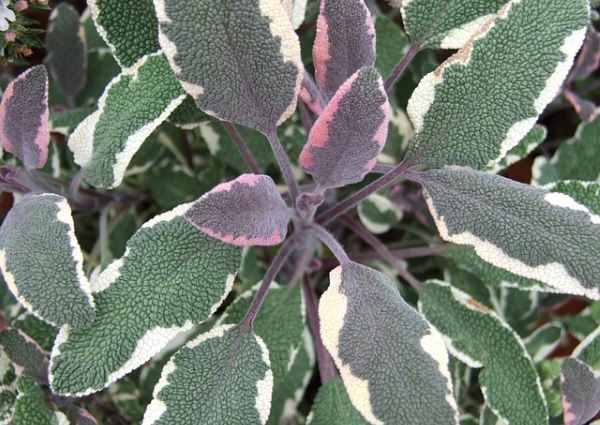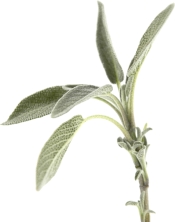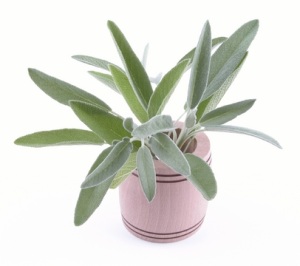Growing Sage Plant Indoors
By growing sage plant on your windowsill, you can enjoy this savory herb year-round. Its strong aroma and flavor make it one of the essential seasonings for hearty dishes.
Don't have a sunny window for it? Growing sage under artificial lights is easy (I'll tell you how). In this guide, you'll discover how to grow sage herb indoors, choose the best varieties, plus get how-tos for seed starting.
 Sage 'Tricolor' is a rare beauty, and worth growing if you can find it.
Sage 'Tricolor' is a rare beauty, and worth growing if you can find it.Get to Know Sage Plant
Known botanically as Salvia officinalis, this is the common garden sage and is a hardy perennial shrub. Its narrow, gray-green leaves have a pebbly, fuzzy texture.
Spikes of violet-blue flowers will appear on mature plants in early summer. Some varieties have purple, golden or variegated leaves and may have purple, red, pink or white flowers.
How big does sage get? It will reach a height of 1-2 ft (30-60 cm), depending on the variety. It's a good idea to grow a dwarf sage variety indoors -- this plant can get too big for the windowsill.
Don't know how to grow sage? It's easy. Native to the northern Mediterranean coast, this herb prefers a sunny spot and well-drained soil.
Sage plant is easily killed by overwatering, so use a container with a drainage hole. Seedlings and young plants should be kept slightly moist, but sage is drought-tolerant once established.
Wait a year before harvesting sage to allow your plant to get established. After the first year, snip fresh leaves as needed. Prune it back after flowering to keep it from getting too leggy. You can cut mature plants back by half in spring or early summer, if you want -- you won't hurt the plant.

Sage Varieties
Several varieties are available, but I recommend the dwarf varieties for growing sage indoors. If another type tickles your fancy, buy it. You can prune sage back harshly after the first year to keep it small.
Some colorful cultivars are available and are just as flavorful for cooking: 'Tricolor' sports grayish-green leaves splashed with creamy white. 'Purpurascens' has dark purple leaves. 'Icterina' features golden-edged leaves.
Suggested dwarf varieties: The dwarf cultivar S. officinalis 'Compacta' reaches only 10 inches high. Smaller leaves, but it has the same sage flavor. S. elegans 'Dwarf' is a smaller variety (12 in tall) of pineapple sage with a wonderful pineapple aroma.
How to Grow Sage Indoors from Seeds
Sage is easy to propagate by seed. The best time for seed starting is in spring. Here's how:
- Fill seedling trays or seed starting cups with seed starting potting mix.
- Water potting medium; it should be thoroughly moist, but not soggy.
- Drop a few seeds in each cup on the top of the moistened mix. Then cover seeds with a sprinkling of potting medium to barely cover the seeds.
- Set the containers in a warm place, where they will stay at a consistent 70°F/21°C. I suggest using a seedling heat mat to ensure constant warmth.
- Water enough to maintain lightly moist potting medium.
- Set them in indirect sunlight, until they have sprouted.
Your seeds will germinate in about 3 weeks. After they have sprouted, you'll want to thin them out to give the plants room to grow. When the plants are a few inches tall, transplant each one into a 6-inch pot filled with fresh potting mix.

Tips for Growing Sage Indoors
Light: Give sage herb at least 6 hours of direct sunlight during the growing season to help it grow lush and full. Turn the plant once in a while because it will tend to grow toward the light source. Move the container outdoors in spring and summer, if you want. Growing sage under artificial light works well, too. Some kitchens have fluorescent or LED lights under the cabinets -- an ideal spot for your culinary herbs. If you use indoor plant lights, keep the light 6 in (15 cm) above the plant and leave it on for 14 hours a day.
Water: Water thoroughly and allow top of soil to dry out between waterings. And remember to use a pot with a drainage hole. Sage will not tolerate soggy soil. When watering, try not to get water on the leaves, which may cause fungus.
Humidity: Average room (around 40% relative humidity).
Temperature: Average to warm 65-80°F/18-27°C.
Soil: Use a fast-draining potting mix, such as cactus mix. Or use 2 parts all-purpose potting mix with 1 part sharp sand or perlite.
Fertilizer: Feed monthly with herb fertilizer according to package directions.


